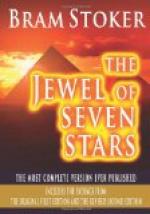“Mr. Trelawny and I went alone into the tomb. We had brought plenty of lights with us; and we fixed them as we went along. We wished to get a complete survey at first, and then make examination of all in detail. As we went on, we were filled with ever-increasing wonder and delight. The tomb was one of the most magnificent and beautiful which either of us had ever seen. From the elaborate nature of the sculpture and painting, and the perfection of the workmanship, it was evident that the tomb was prepared during the lifetime of her for whose resting-place it was intended. The drawing of the hieroglyphic pictures was fine, and the colouring superb; and in that high cavern, far away from even the damp of the Nile-flood, all was as fresh as when the artists had laid down their palettes. There was one thing which we could not avoid seeing. That although the cutting on the outside rock was the work of the priesthood, the smoothing of the cliff face was probably a part of the tomb-builder’s original design. The symbolism of the painting and cutting within all gave the same idea. The outer cavern, partly natural and partly hewn, was regarded architecturally as only an ante-chamber. At the end of it, so that it would face the east, was a pillared portico, hewn out of the solid rock. The pillars were massive and were seven-sided, a thing which we had not come across in any other tomb. Sculptured on the architrave was the Boat of the Moon, containing Hathor, cow-headed and bearing the disk and plumes, and the dog-headed Hapi, the God of the North. It was steered by Harpocrates towards the north, represented by the Pole Star surrounded by Draco and Ursa Major. In the latter the stars that form what we call the ‘Plough’ were cut larger than any of the other stars; and were filled with gold so that, in the light of torches, they seemed to flame with a special significance. Passing within the portico, we found two of the architectural features of a rock tomb, the Chamber, or Chapel, and the Pit, all complete as Van Huyn had noticed, though in his day the names given to these parts by the Egyptians of old were unknown.
“The Stele, or record, which had its place low down on the western wall, was so remarkable that we examined it minutely, even before going on our way to find the mummy which was the object of our search. This Stele was a great slab of lapis lazuli, cut all over with hieroglyphic figures of small size and of much beauty. The cutting was filled in with some cement of exceeding fineness, and of the colour of pure vermilion. The inscription began:
“’Tera, Queen of the Egypts, daughter of Antef, Monarch of the North and the South.’ ‘Daughter of the Sun,’ ‘Queen of the Diadems’.
“It then set out, in full record, the history of her life and reign.
“The signs of sovereignty were given with a truly feminine profusion of adornment. The united Crowns of Upper and Lower Egypt were, in especial, cut with exquisite precision. It was new to us both to find the Hejet and the Desher—the White and the Red crowns of Upper and Lower Egypt—on the Stele of a queen; for it was a rule, without exception in the records, that in ancient Egypt either crown was worn only by a king; though they are to be found on goddesses. Later on we found an explanation, of which I shall say more presently.




